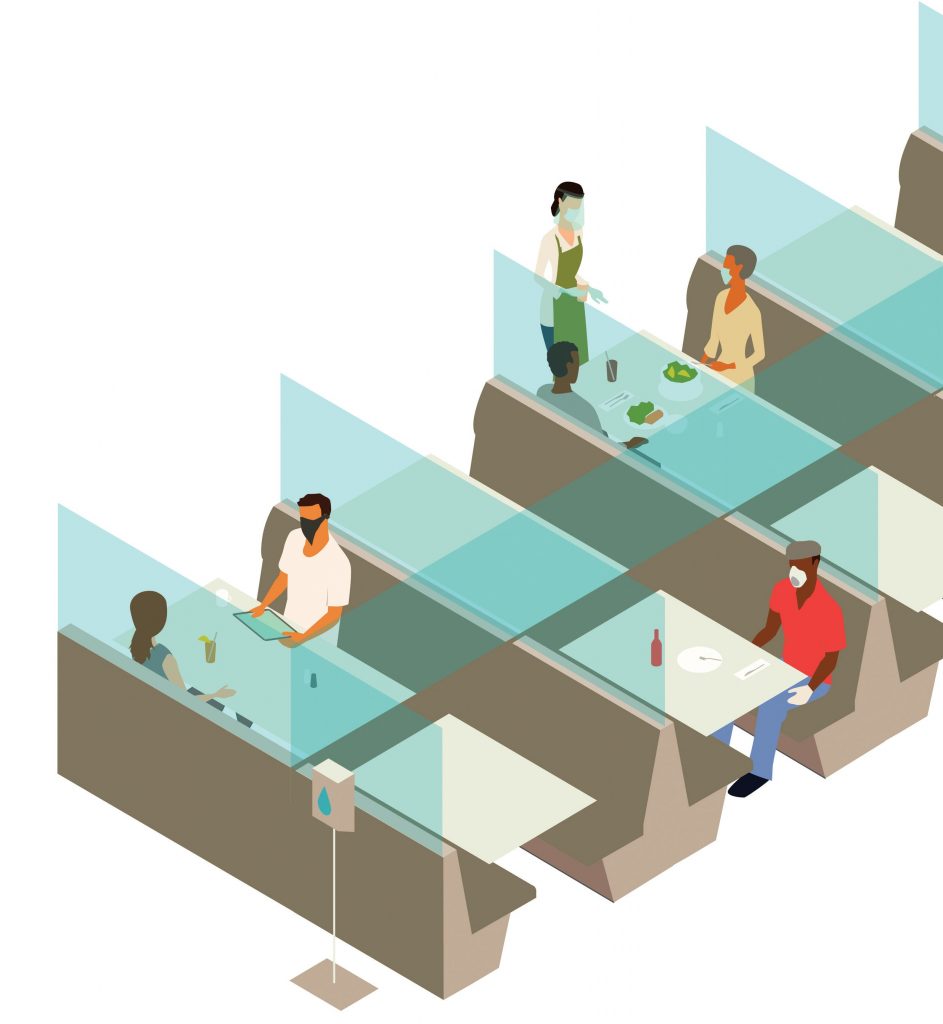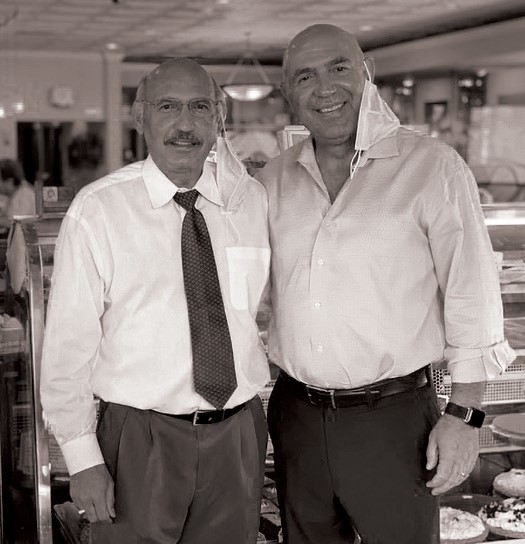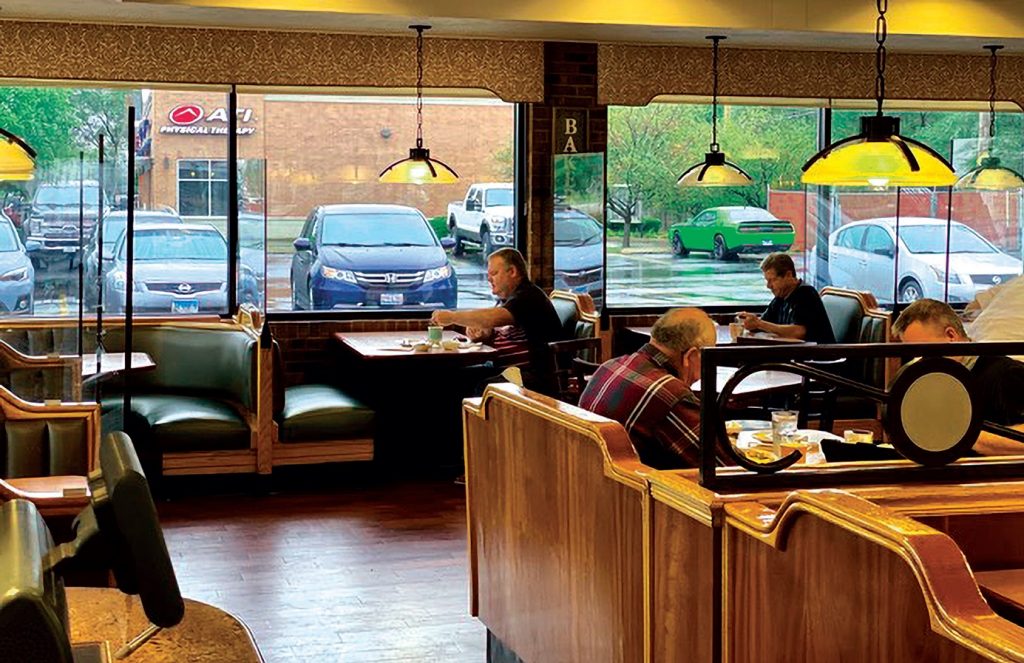Divided We Dine
Posted by estiator at 11 November, at 11 : 05 AM Print
FEATURE
Steve Theofanous launches Social D Partitions to help restaurants welcome back diners safely. By Michael Kaminer

TUCKED INTO THE Center for Disease Control’s recent Considerations for Restaurants and Bars—guidelines to help hospitality businesses operate safely—is a recommendation about Physical Barriers and Guides.
“Install physical barriers, such as sneeze guards or partitions, particularly in areas where it is difficult for individuals to remain at least 6 feet apart,” the guidelines urge. “Barriers can be useful.”
But one Illinois restaurateur figured that out for himself. A 45-year industry veteran, Steve Theofanous noticed diners didn’t feel completely comfortable returning indoors this summer to Around the Clock, his family restaurant in Crystal Lake, about 50 miles northwest of Chicago. A lightbulb went off.
Working with his own construction crews and Chicago-area contractor whose clients include Motorola, Theofanous designed dividers for Around the Clock made of customized acrylic supported by steel posts. “We had done renovations during the shutdown, and we’d never made the decision to serve outdoors,” he tells Estiator. “Instead, we wanted to maximize indoor dining to make people feel safer.”
The result: “Customers are telling us they’ve never felt safer dining in a restaurant,” he says. When some of those customers, restaurateurs themselves, asked where he sourced the dividers, Theofanous had another epiphany. “I thought, we have the customers and we have the crew,” he says. “There is a need in our industry. If you don’t have dividers, you can’t maximize seating capacity.”
Theofanous’ Social D Partitions was born. The new company customizes dividers for restaurants across the country, shipping the acrylic panels and metal posts with instructions and videos on installation. “All it takes is some basic knowledge of assembly and construction,” he says.
The dividers themselves extend six feet and one inch from the floor, exceeding the CDC’s guidance by an inch. Each divider comes in clear acrylic that’s 3/16″ thick, “which is seven times stronger than glass. They won’t break, like glass. And even though acrylic is not as strong as Plexiglas, Plexi is softer and scratches much more easily.”
Aesthetics are a major consideration too, Theofanous says. In his own restaurant, the metal support poles— made of 16-gauge mild steel— are powder-coated in a rich bronze tone. “They’re also a little bendable, so we can adjust them as needed,” he says. “And the process of how they’re powder-coated and baked is pretty cool.”
Social D Partitions dividers cost about $200 apiece, Theofanous says; it takes up to two weeks to fulfill a client’s custom order. Theofanous contends it’s worth the short wait and the cost. “A lot of people rushed to put something in hastily, just to create some kind of divider. My philosophy is that it’s better to do it right the first time so you don’t have to pay for it twice.”
While Social D Partitions just launched, Theofanous himself has been a familiar presence for Estiator readers. In a story last year, he talked about his leadership of Chicagoland’s Greek-American Restaurant Association Cooperative, the largest organization of its kind in the U.S.
Theofanous’ personal story—involving family, immigration, and a lot of hard work—will also resonate.
His family came to Illinois from Cyprus when Theofanous was 11 and his brother, Fano, was 9. His mother’s brother, who had been in the restaurant business, sponsored their immigration. In 1975, Theofanous’ father and a partner opened Around the Clock restaurant in Crystal Lake. “As the name says, we were one of the few restaurants in the area stay open 24-7,” Theofanous remembers. “When we moved here, it was a farm town with a two-lane highway.” He and his brother, who worked at the restaurant through their high school years, took over the business in 1983.
Over the years, the brothers have added their own signature touches—not all of them planned. When a pie supplier went out of business several years ago, an Around the Clock employee told the brothers she knew how to make pies. “She made a banana cream pie at home, and customers loved it,” Theofanous says. “We started making pies in the basement and built an in-house bakery. That made us different from other restaurants, and we make our own pies to this day—with all-natural ingredients, and the dough rolled out by hand.” Custom cookies have also become a hallmark. “When people come in, the first thing they see is this beautiful case with pastries, pies, and cookies, all made in-house. That separates us.”
So popular did Around the Clock become that the brothers expanded about 20 years ago, increasing capacity from 145 to 175 seats. When coronavirus hit and the restaurant was forced to temporarily shutter, “we used that opportunity to remodel,” Theofanous says. The brothers, who also run a property-management company with its own crew, gutted and modernized the restaurant’s bathrooms, upgraded kitchen equipment, replaced carpeting, and installed new ceiling tiles. “I like to say we’re one of the oldest restaurants in the community, and now we’re one of the newest,” Theofanous says.
Social D Partitions is also part of the brothers’ next chapter. Once Theofanous started promoting Around the Clock’s “partitioned indoor dining” on social media, “people started flocking in,” he says. “If they’re going to dine indoors at all, they want to feel safe.” Likewise, some proprietors are using wood or thin Plexiglas as a stopgap measure, but Theofanous claims “they don’t give guests the feeling of safety or security. They might work temporarily, but these partitions are built to last.”
The new business has been a work in progress; when the brothers learned that restaurants with vinyl booths couldn’t install dividers using nails—which would destroy the booths—Theofanous created a custom bracket that eliminates the need for nails in installation.
Next for Social D Partitions: More creativity in its divider designs. “Some people want different trims. We can screenprint a restaurant’s name on a panel. We’re ready to customize to whatever they need,” he says.
Safe Operating Advice / for Our Industry
Throughout the pandemic, the National Restaurant Association has been offering calm, clear guidance to help proprietors serve customers while protecting public health. The association also maintains a constantly updated database of COVID-related resources for restaurateurs.
Behind many of the recommendations: Larry Lynch, the organization’s vice president for food science and industry, who has issued advice on everything from addressing sick employees to safe and successful reopenings. “I talk to the FDA three or four times a week. They’ve been good partners,” he tells Estiator. “And I reach out to the CDC for answers when questions come in.”
With more cities allowing limited indoor dining and more restaurants seeking out companies like Social D Partitions to help comply with new rules, Estiator talked to Lynch about some best practices, worst-case scenarios, and hopeful outcomes.
There still seems to be some confusion among operators about best practices as they reopen. What would you say is the top consideration for safety?
We’re focused first and foremost on face coverings. In the beginning, when every restaurant was focused on takeout and delivery, you didn’t see a single outbreak from those kitchens, because people were wearing face coverings.
Are Plexiglas or acrylic barriers effective safety measures indoors?
It depends how they’re used. A properly placed barrier, with the right height and coverage, should work. We’re also suggesting that operators space out tables six feet apart, chair-back to chair-back.
Another consideration is that there’s still a lot that’s unknown about airborne transmission and air circulation. And there are so many types of buildings represented in the restaurant industry. Some may have older HVAC systems, or may not have a system that can accommodate the MERV 13 filters [the highest-performing filters in non-healthcare facilities]. We’re telling people to work with a contractor, get a thorough cleaning, and install the highest level of filter you can use with your existing system. Admittedly, you’ll incur out-of-pocket expenses doing things with your HVAC. But as winter approaches in places like New York City, you should be doing that work anyway.
As customers return to dining rooms in greater numbers, what are some concerns in terms of flow and traffic?
One key thing is that it’s a natural tendency for people to congregate in restaurants as they’re waiting for a seat, sometimes around the host stand. We’re suggesting that operators use basic technology. It can be something as simple as, “Text us when you’re coming.” Or you can let customers wait in their cars until a table is ready, which eliminates the risk at front of house. Use your web site or social media to inform people about your policies. And let them know about all of the other steps you’ve taken, from putting hand sanitizers on tables to paper menus— anything you can think of that’s out of the box.
What would you tell restaurateurs who are just exhausted by the whole situation?
I love Greek food, and I want Greek restaurants to succeed. I’d tell them to reach out to your local restaurant community. See what other people are doing. Find out who you can talk to. I’ve always found that in running businesses, reaching out to my peers was the best way to come up with answers. It’s important to keep in mind that we’re not going back to “normal.” The industry is getting reset. There will be changes in how people are accessing restaurants.
Editor’s note: The National Restaurant Association recently rolled out the ServSafe Dining Commitment, a program that helps restaurants welcome back diners by sharing a commitment to training, safe food handling, and safe dining. Visit https://commit. servsafe.com/ for more.
Larry Lynch “I talk to the FDA three or four times a week. They’ve been good partners,” he tells Estiator. “And I reach out to the CDC for answers when questions come in.”

















